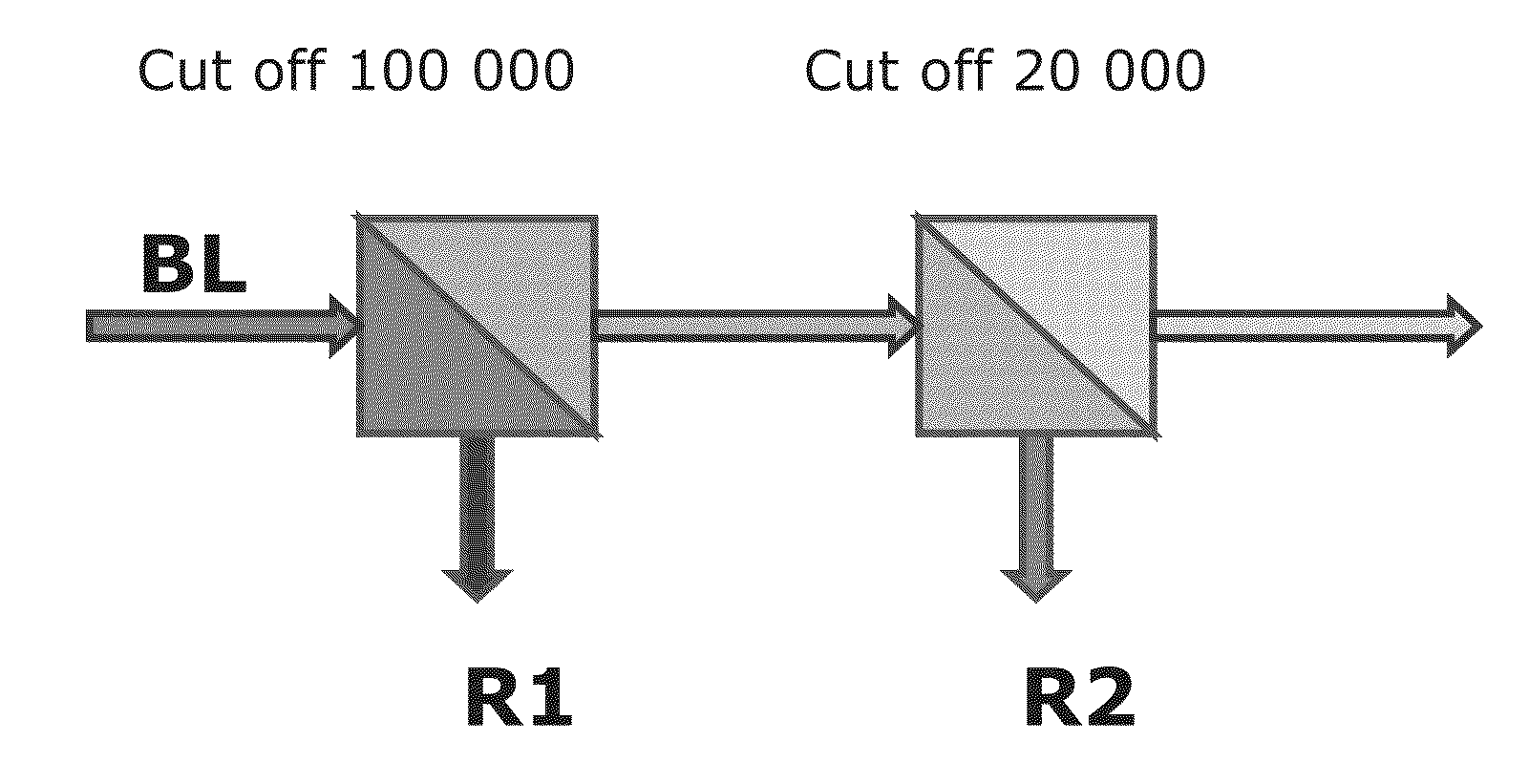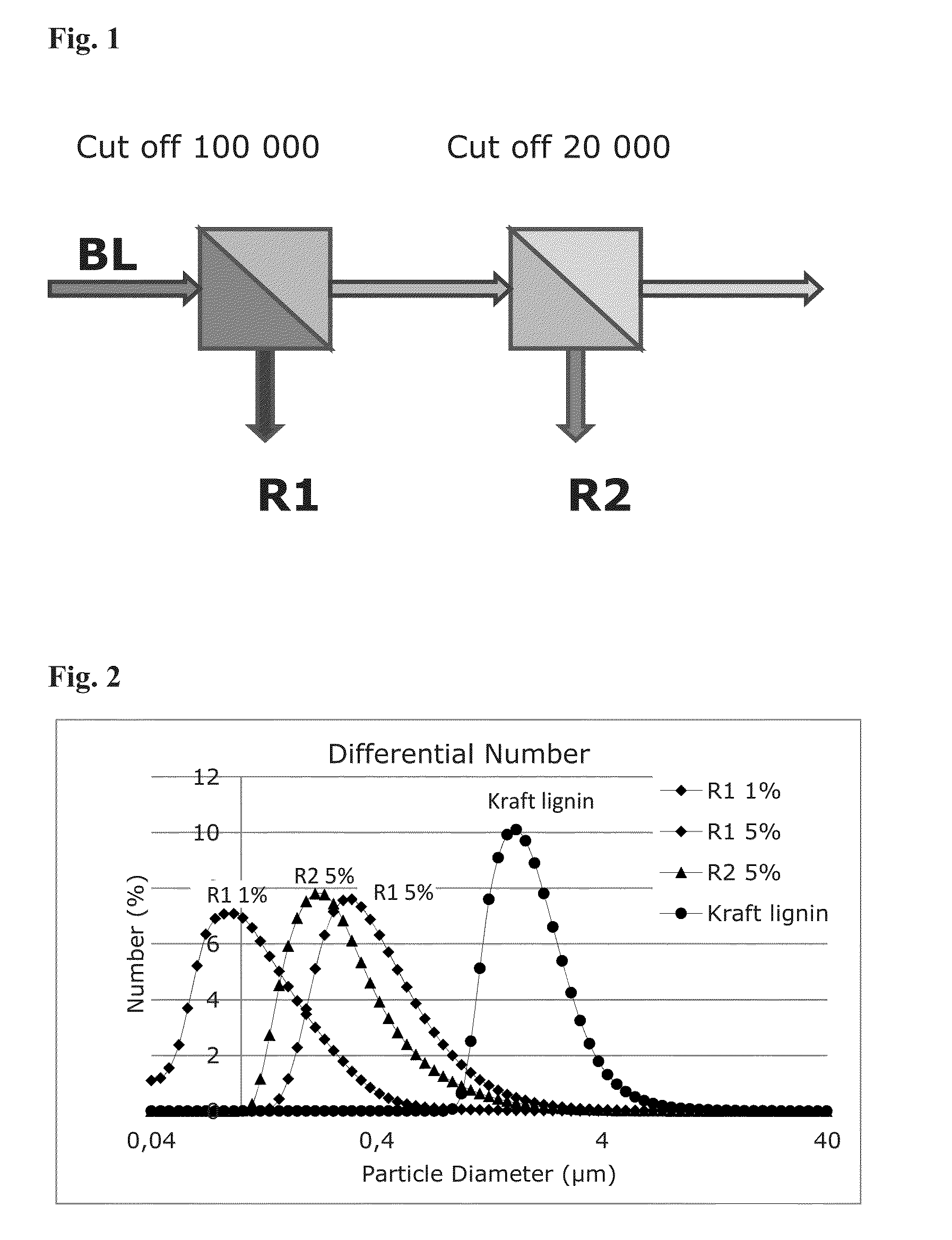Process for the hydrothermal treatment of high molar mass biomaterials
a biomaterial and hydrothermal treatment technology, applied in the direction of physical/chemical process catalysts, metal/metal-oxide/metal-hydroxide catalysts, waste based fuel, etc., can solve the problem that no reason has been found for separating biomass into fractions
- Summary
- Abstract
- Description
- Claims
- Application Information
AI Technical Summary
Benefits of technology
Problems solved by technology
Method used
Image
Examples
example 1
Separation of Kraft Black Liquor into Fractions
[0049]Kraft black liquor was subjected to ultrafiltration using different cut-off values to obtain fractions of varying molar mass. The contents of different components in said fractions were measured (see the following Table 1).
TABLE 1Ultrafiltration balances (in %)blackcut-off:cut-off:cut-off:remainingliquor100,00020,0005,000fractionDry content18.030.717.111.910.6lignin3255533124hemicellulose413.62.30.40.1ash4527444776Σ (lig + hemi + ash)81.095.699.378.4100.1carbon3347413126
[0050]The high molar mass fractions were selected for subsequent treatment due to their high carbon contents.
example 2
Production of Carbon from Lignin by HTC
[0051]Lignin has been found particularly suitable for use as a starting material in the present process, among others due to its high carbon content, but also due to the fact that lignin can be extracted in high yields, for example, from black liquor (see the above Table 1), where it forms a by-product. In some pulping processes, lignin separation is even required to increase pulp production.
[0052]In this example, pure lignin was extracted from kraft black liquor by CO2 precipitation, and subjected to HTC at a treatment temperature of about 200° C. and a treatment pressure of about 20 bar. The product mixture (having a carbon content of about 80%) was subjected to dissolution with water, and filtration to obtain a pure dry carbon product.
[0053]The carbon content of the product was measured, and compared to the contents of untreated lignin, cellulose, hemicellulose and crude oil. The compositions of these biofractions (cellulose, hemicellulose, ...
example 3
Production of Nanosized Carbon Particles from Black Liquor Lignin Using HTC
[0056]Black liquor lignin was fractionated to fractions with the cut off 100 000 (R1) and 20 000 (R2) according to Table 1, Example 1, as well as FIGS. 1. R1 and R2 were further processed with HTC. We used following conditions: temperature 180-230° C., residence time 6 h, dry matter 1% and 5%, no additional catalyst, pH alkaline (corresponding to pH of black liquor). Kraft lignin was used as a reference material and it was precipitated from kraft black liquor according to Example 2.
[0057]The number average particle size distribution was determined for the obtained products and reference material to give the results of FIG. 2 and Table 4. According to the results, HTC can be used as a method to reduce the particle size of the original raw material and to produce nanosized carbon particles for example for carbon black applications.
TABLE 4Mean particle size presented as differential number for kraft lignin(refer...
PUM
| Property | Measurement | Unit |
|---|---|---|
| pressure | aaaaa | aaaaa |
| temperature | aaaaa | aaaaa |
| temperature | aaaaa | aaaaa |
Abstract
Description
Claims
Application Information
 Login to View More
Login to View More - R&D
- Intellectual Property
- Life Sciences
- Materials
- Tech Scout
- Unparalleled Data Quality
- Higher Quality Content
- 60% Fewer Hallucinations
Browse by: Latest US Patents, China's latest patents, Technical Efficacy Thesaurus, Application Domain, Technology Topic, Popular Technical Reports.
© 2025 PatSnap. All rights reserved.Legal|Privacy policy|Modern Slavery Act Transparency Statement|Sitemap|About US| Contact US: help@patsnap.com


